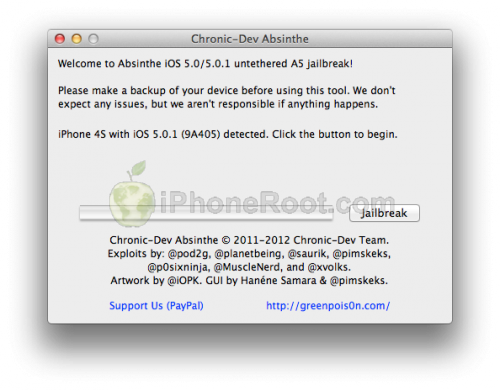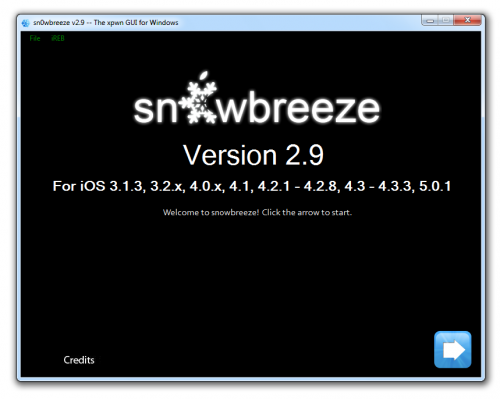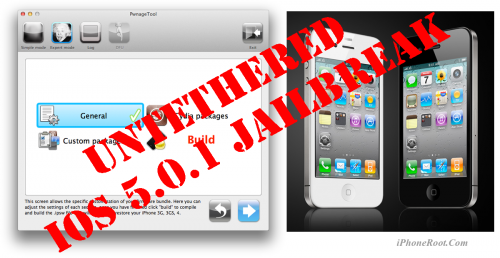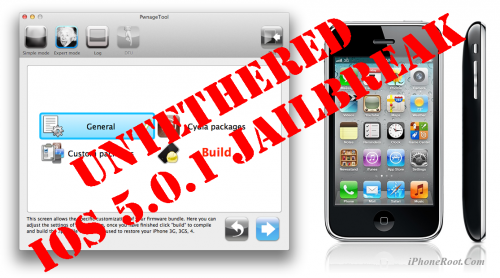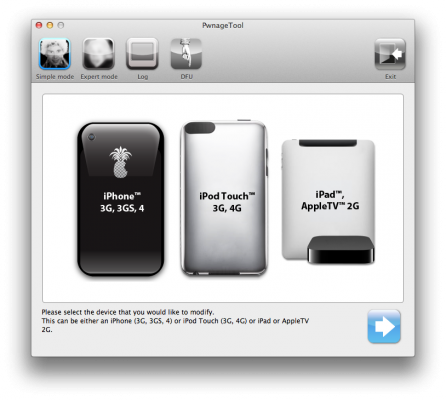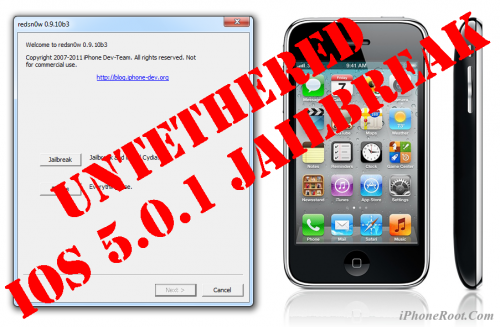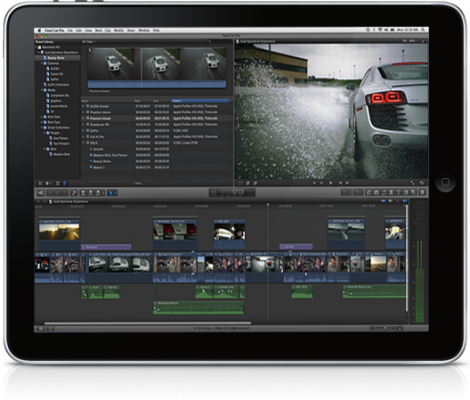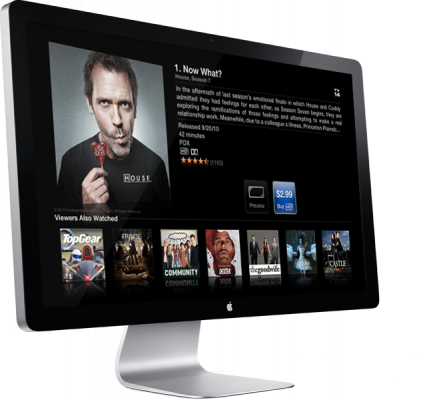News tagged ‘IPS’
Jailbreak for iPhone 4S and iPad 2 Has Been Released
The 'Dream Team' of hackers have just released their untethered jailbreak for the iPhone 4S and the iPad 2. The utility is called Absinthe.
The initial release is currently for Mac OS X only but Windows is coming soon!
You can download Absinthe here.
Here are our step-by-step tutorials:
- HowTo untether jailbreak iPad 2 with iOS 5.0.1 (Mac OS X)
- HowTo untether jailbreak iPhone 4S with iOS 5.0/5.0.1 (Mac OS X)
- HowTo untether jailbreak iPad 2 with iOS 5.0.1 (Windows)
- HowTo untether jailbreak iPhone 4S with iOS 5.0/5.0.1 (Windows)
UPDATE: Absinthe for Windows is ready - read here!
Usage tips:
 Leave a comment, read comments [10]
Leave a comment, read comments [10]
Apple to Launch 'Garageband for e-books' on Thursday
This week, on Thursday, January 19, Apple plans to hold its education-related media event. Last week Apple sent out invitations for the event with a tagline stated that the company would make an "education announcement in the Big Apple." The multiple reports are claiming that the company could announce an initiative to help textbook makers produce interactive ebooks for the iPad, with some sources calling the initiative "Garageband for e-books."
ArsTechnica reported on Monday that its sources are claiming that Apple will release a simple app that makes e-book publishing as easy as recording a song in GarageBand. Inkling CEO Matt MacInnis, who worked on education projects at Apple before leaving to focus on interactive e-books, also confirms the rumors, because he dosn't believe that Apple would start releasing content to replace, for example, textbooks, the company is likely to provide content production tools, similar to its own Logic or Final Cut Pro software.
Sn0wBreeze 2.9 released: brings iOS 5.0.1 untether
iH8sn0w has released new version of popular jailbreak utility Sn0wBreeze 2.9. Sn0wbreeze is used to create a custom firmware with jailbreak and preserve iPhone modem (baseband) version for unlock. New version 2.9 adds support for untethered iOS 5.0.1 jailbreak as well as support for all firmwares supported by previous versions of sn0wbreeze.
For now Sn0wBreeze 2.9 supports untethered jailbreak for iOS 3.1.3, 3.2.x, 4.0.x, 4.1, 4.2.1 - 4.2.8, 4.3 - 4.3.3 and 5.0.1. Supported devices are: iPhone 2G, iPhone 3G, iPhone 3GS, iPhone 4, iPad 1, iPod Touch 2G, iPod Touch 3G, iPod Touch 4G.
 Leave a comment, read comments [14]
Leave a comment, read comments [14]
Step-by-step Tutorial: How to Untether Jailbreak and Unlock iPhone 4 Using PwnageTool 5.0.1 (Mac OS) [iOS 5.0.1]
UPDATE: Apple released iOS 5.1 firmware. Apple has stopped signing iOS 5.0.1, so you can NOT restore to 5.0.1 any more. If you are on 5.0.1 you can jailbreak with RedSn0w.
Using this tutorial you will be able to untether jailbreak iOS 5.0.1 running on iPhone 4. Pwnagetool will also preserve baseband version if you need carrier unlock. This tutorial uses PwnageTool 5.0.1 for Mac OS X.
 Leave a comment, read comments [68]
Leave a comment, read comments [68]
Step-by-step Tutorial: How to Untether Jailbreak and Unlock iPhone 3GS Using PwnageTool 5.0.1 (Mac OS) [iOS 5.0.1]
UPDATE: Apple released iOS 5.1 firmware. Apple has stopped signing iOS 5.0.1, so you can NOT restore to 5.0.1 any more. If you are on 5.0.1 you can jailbreak with RedSn0w.
Using this tutorial you will be able to untether jailbreak iOS 5.0.1 running on iPhone 3GS. Pwnagetool will also preserve baseband version if you need carrier unlock. If you have updated the baseband to version 06.15, you can use this tutorial to update to iOS 5.0.1. This tutorial uses PwnageTool 5.0.1 for Mac OS X.
 Leave a comment, read comments [9]
Leave a comment, read comments [9]
Reportedly Foxconn And Pegatron Begin Assembly Of iPad 3 For Early-March Launch
Japanese blog Macotakara that Apple’s contract manufacturers Pegatron Technology and Foxconn Electronics was commisioned to begin assembly of next iPads for a launch in early March.
Apple is working on Siri Dictation for the iPad, iOS 5.1 beta reveals
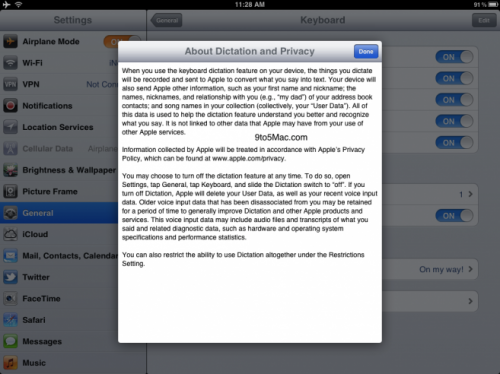
9to5Mac has reported a couple of hours ago that has discovered something potentially major: Siri Dictation references inside the iOS 5.1 beta 3 released today. Sonny Dickson (9to5Mac’s tipster) was looking through the iOS 5.1 beta 3 settings application on the iPad and discovered a new section in the keyboard menu called “About Privacy and Dictation.” When he opened it, as shown above, the iPad provides the user with the standard legal literature and feature information for Siri Dictation.
Dictation is not actually functional on the iPad 2 running iOS 5.1 beta 3, so perhaps this will be an iOS 5.1 launch feature for the iPad, or it may be an iPad 3-exclusive feature; a similar process to the iPhone 4S exclusively gaining Siri and Siri Dictation support in iOS 5.0. We’re also hearing this link/document is also appearing on retina iPod touches as well.
 Leave a comment, read comments [2]
Leave a comment, read comments [2]
Step-by-step Tutorial: How to Untether Jailbreak Apple TV 2G Using Seas0nPass (Windows / Mac OS) [iOS 4.4.4]

Using this tutorial you will be able to untether jailbreak iOS 4.4.4 running on Apple TV 2G. This tutorial uses Seas0nPass for Mac OS X or Windows.
UPDATE: Please, consider reading our Jailbreak & Unlock FAQ, especially if you have questions or troubles.
Step one
- Make sure you're running the latest version of iTunes.
- Download Seas0nPass: |
- A micro USB cable will be required to connect Apple TV 2G to computer.
- Disconnect all iPods, iPhones, and iPads from the computer before running Seas0nPass.
Evidence of Quad-Core Chips Shows Up in iOS 5.1 Betas
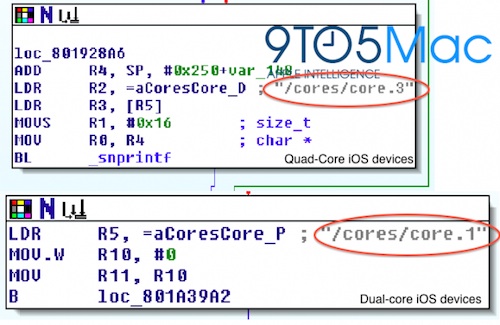
9to5Mac found evidence of support for quad-core processors that was hidden deep inside the latest iOS 5.1 beta. Apple leaving references to quad-core chips in the iOS 5.1 beta is notable because iOS 5.1 is the software currently being tested against the third-generation iPad.
Extremely reliable and knowledgeable people familiar with iOS’s inner workings explained to me that core references begin at “0.” For example: A single core device would be limited to ”/cores/core.0,” and a dual-core device would come in at ”/cores/core.1.” A “core.2″ (which is not referenced in iOS code) would be a triple-core processor according to this labeling method. iOS 5.1 beta 2 now includes core.3, a seemingly quad-core chip from Apple. Above, you can view a comparison between the pre-iOS 5.1 beta iOS core management software and the iOS 5.1 beta version. The dual-core A5 chip, on the bottom, has the “core.1,” and the quad-core chip, on top, supporting iOS 5.1 beta is marked with the “core.3.”
iPhone Dev-Team Releases PwnageTool 5.0.1 for iOS 5.0.1
The iPhone Dev-Team has updated PwnageTool with support for the iOS 5.0.1 untethered jailbreak. PwnageTool lets you easily create a custom ipsw for upgrading to iOS 5.0.1.
Unlockers can use custim firmware to preserve baseband version and unlock with ultrasn0w or gevey. Depending on your device you can also configure the ipsw with boot logos and Cydia packages.
PwnageTool 5.0.1 supports iPhone 3GS, iPhone 4, iPad 1, Apple TV 2G, iPod Touch 3G, iPod Touch 4G.
You can download the new version of PwnageTool 5.0.1 from here.
UPDATE: Here are our step-by-step tutorials that will guide you through all the process of untethered jailbreaking iOS 5.0.1 with PwangeTool 5.0.1:
 Leave a comment, read comments [3]
Leave a comment, read comments [3]
Step-by-step Tutorial: How to Untether Jailbreak and Unlock iPhone 3GS Using RedSn0w 0.9.10 (Windows) [iOS 5.0.1]
UPDATE: Apple released iOS 5.1 that is only tethered jailbreakable with redsn0w. Apple has stopped signing iOS 5.0.1, so you can NOT restore to 5.0.1 any more (both original and custom), unless you have saved your SHSH keys for 5.0.1. If you are on 5.0.1 you can jailbreak with redsn0w.
This is step-by-step instructions on how to perform untethered jailbreak of your iPhone 3GS on iOS 5.0.1 firmware using RedSn0w 0.9.10 for Windows.
Untethered jailbreak means that each time you restart your device you will NOT need to connect it to a computer and run utilities.
Important: If you need unlock and have 05.13 baseband or lower - do not update to Apple firmware, use RedSn0w or Sn0wBreeze to create custom firmware!
If you need unlock Redsn0w will provide you with choice of updating your baseband to 06.15. If you have new iPhone 3GS that was made after 35 week of 2011 upgrading modem will not help to unlock.
 Leave a comment, read comments [470]
Leave a comment, read comments [470]
Apple to ship high-res 'iPad 3' in March, 'iPad 4' in October
Citing component makers in Taiwan, DigiTimes reported on Friday that the so-called "iPad 3" will launch in March with a high-resolution Retina Display, while an "iPad 4" will arrive in October of this year to counter a rumored Google-branded tablet as well as touchscreen devices running Microsoft's Windows 8 operating system.
Apple will ship the so-called "iPad 3" with a full HD display in March and then "iPad 4" - named so by its component suppliers - with killer applications in October, according to industry sources in Taiwan. [...]
But a true battle for market share will arrive in the second half of the year when Apple ships its iPad 4 in October, about the time when Microsoft releases its Window 8 and Intel unveils its Clover Trail-W platform, the sources commented.
The 9.7-inch iPad 4 is expected to come with much upgraded hardware specifications and integrated applications so as to compete with an array of Android-, Wintel- or WoA (Windows on ARM)-based tablet PCs to be released in the fourth quarter, said the sources.
Finally, Digitimes suggests that Apple will continue to sell the current iPad 2, but will drop its price to $399, much like Apple currently does with older iPhone models, to counter lower priced tablets that are available, such as the Kindle Fire for $199.
iPhone 4S users consume nearly twice as much data as iPhone 4
Telecom network technology firm Arieso has found that data usage of the iPhone 4 was 1.6 times higher than the iPhone 3G, while iPad 2 tablets consumed 2.5 times more data. The iPhone 4S was the heaviest on usage with three times the amount used by the iPhone 3G.
"I use the iPhone 4 myself and when I first heard of the iPhone 4S features I was not compelled to rush out and get one. However, the data usage numbers I am seeing make me wonder what I am missing," Arieso's chief technology officer, Michael Flanagan, said of the study.
Flanagan also noted that tablet usage closely resembled that of high-end smartphones. "A tablet still looks like a big smartphone," he said. Bloomberg also confirms Arieso's research claiming that one percent of the high-use subscribers consumed half of the data volumes. “The hungry are getting hungrier,” Flanagan said.
The rise in iPhone data consumption comes as Sprint is the only U.S. network to offer an unlimited data plan. The iPhone has actually brought broad changes in the wireless industry. AT&T, Apple's original carrier partner in the U.S., was initially surprised by the amount of data users consumed. The iPhone maker has also opted to wait for 4G LTE to become more mature. CEO Tim Cook said that the first generation of LTE chipsets required "design compromises" that Apple was unwilling to make. Apple may release LTE iPad and iPhone models this year.
Designer Jony Ive reportedly has a 50-inch Apple television in his studio
Citing an anonymous source who worked at Apple, USA Today revealed that 50-inch Apple television is said to be housed in the secure California studio of Jonathan Ive. The same source also said that Apple is looking to build an LCD television sized 42 inches or larger with built-in Wi-Fi functionality, because Apple is not interested in building an HDTV with a screen size of less than 42 inches.
Author Scott Martin notes that Apple's rumored TV set is going to receive "big buzz" at next week's Consumer Electronics Show, even though the Cupertino, Calif., company isn't attending the event.
The story also features a quote from Apple co-founder Steve Wozniak, who said he expects Apple will make "an attempt" to build a TV. He believes the living room will "remain a center for family entertainment, and that touches on all areas of consumer products that Apple is already making."
The report offers little else that is new about Apple's anticipated television set. Some reports have indicated that Apple plans to use custom chips, like it does with the iPhone, iPad and iPod touch, others suggested that Apple could include AirPlay and iCloud into its new product. Rumors also claim that Apple wants to be able to offer customers customized channel lineups with its anticipated television set to choose whichever channels or shows they want for a monthly subscription fee.
Hidden Stanford archive houses largest collection of historical Apple materials
In late 1990s, when Apple had some financial hardships the company elected to turn over its trove of materials to Stanford University's Silicon Valley Archives. Apple had been collecting the materials with the intention of forming its own company museum. The materials include "hundreds of box" requiring more than 600 feet of shelf space and has early photos of a young Steve Jobs and Steve Wozniak, blueprints for the first Apple computer, user manuals, magazine ads, TV commercials, company t-shirts and drafts of Jobs' speeches.
The university hopes its efforts will ultimately help historians, entrepreneurs and policymakers understand how a startup launched in a Silicon Valley garage by two college dropouts grew into the world's largest company.
